英语基础模块2第一单元教案1.2
- 格式:doc
- 大小:154.50 KB
- 文档页数:7
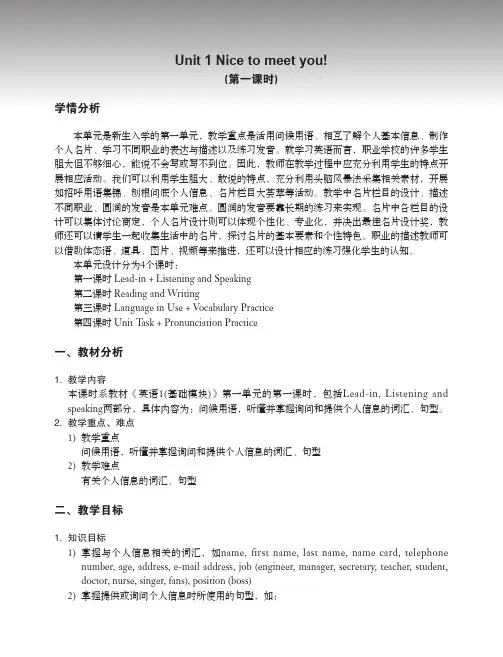
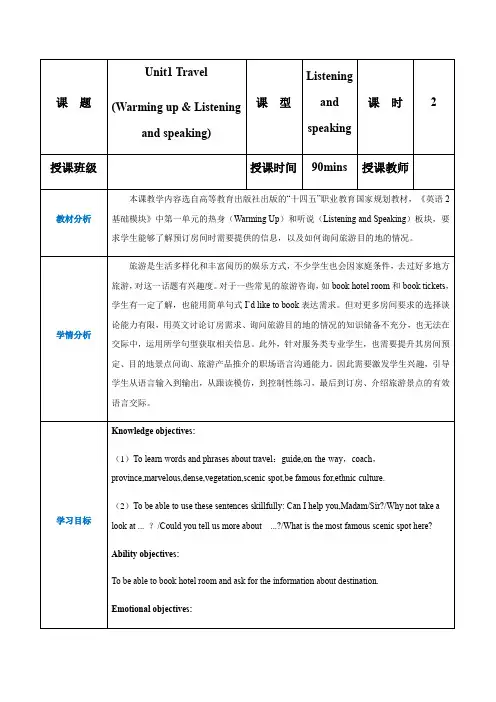
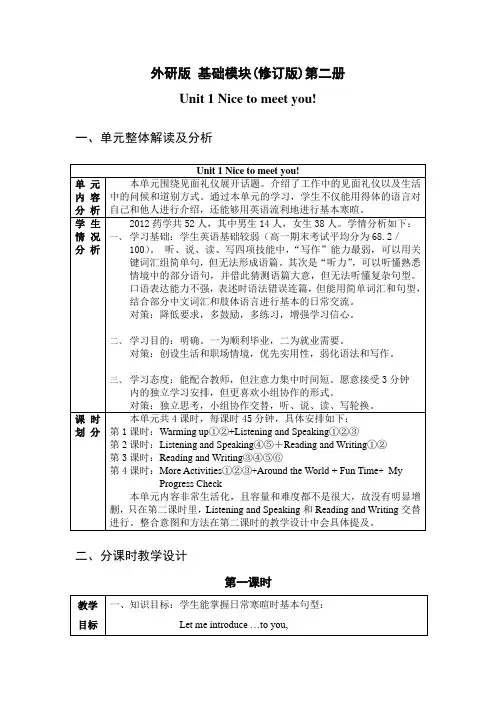
外研版基础模块(修订版)第二册Unit 1 Nice to meet you! 一、单元整体解读及分析二、分课时教学设计第一课时时间环节意图3’导入一、师生互动二、教师随机提问:Who was the first one yougreet in the school this morning?What did you say?教师把回答板书在黑板上。
集体回答。
个别回答。
拉近师生距离,迅速进入主题。
38’听说练习Pre-listening:1)头脑风暴:We have met many familiars. NowI will introduce a new comer David toyou. Let’s say something tohim.教师展示图片。
并把学生的回答写在黑板上。
注意书写位置要便于下一环节的归类。
已有的内容直接在板书上划出来。
2)角色扮演:教师请学生两人一组,借鉴板书上的句型,完成和David的对话。
教师把学生使用的新句型写在黑板上。
学生举手回答。
学生准备两分钟后和搭档们进行对话,教师将选择其中三组上台作“角色扮演”。
“头脑风暴”的意图有两个:一是为了让学生联想起大脑中已储存的“寒暄”句型。
为下一步的听力作准备。
二是为活动③Listenagain and act中的句型拓展作铺垫。
“角色扮演”的意图有两个:一是通过对话对听力材料进行预设,降低学生对听力练习的焦虑。
二是拓展句型,丰富活动③Listen againand act环节学生输出时的语言。
While-listening: 1)“拼图”①播放录音第一遍Tell me what you hear in the dialogue. Any word, phrase, or sentence is good.教师把学生回答的内容写在黑板上,板书时要注意有意识地按照课文顺序进行书写。
2)“拼图”②播放录音第二遍Add the information you hear.3)补充“拼图”Discuss with your group members and fill in the blanks with your own words. Then show the dialogue to us in class.4)完成“拼图”播放录音第三遍,同步显示听力材料。
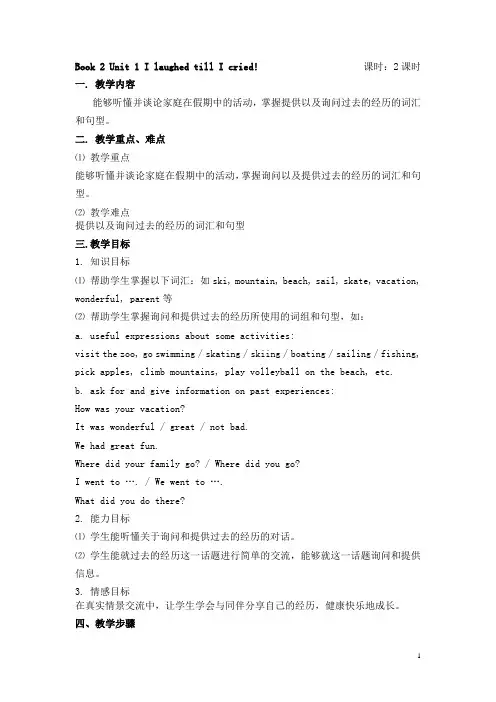
Book 2 Unit 1 I laughed till I cried!课时:2课时一. 教学内容能够听懂并谈论家庭在假期中的活动,掌握提供以及询问过去的经历的词汇和句型。
二. 教学重点、难点⑴ 教学重点能够听懂并谈论家庭在假期中的活动,掌握询问以及提供过去的经历的词汇和句型。
⑵ 教学难点提供以及询问过去的经历的词汇和句型三.教学目标1. 知识目标⑴ 帮助学生掌握以下词汇:如ski, mountain, beach, sail, skate, vacation, wonderful, parent等⑵ 帮助学生掌握询问和提供过去的经历所使用的词组和句型,如:a. useful expressions about some activities:visit the zoo, go swimming / skating / skiing / boating / sailing / fishing, pick apples, climb mountains, play volleyball on the beach, etc.b. ask for and give information on past experiences:How was your vacation?It was wonderful / great / not bad.We had great fun.Where did your family go? / Where did you go?I went to …. / We went to ….What did you do there?2. 能力目标⑴ 学生能听懂关于询问和提供过去的经历的对话。
⑵ 学生能就过去的经历这一话题进行简单的交流,能够就这一话题询问和提供信息。
3. 情感目标在真实情景交流中,让学生学会与同伴分享自己的经历,健康快乐地成长。
四、教学步骤Step One Lead-in (25 mins)1. The teacher greets each student:Good morning.Nice to see you again.Welcome back to school.What did you do during your winter vacation?Did your family go somewhere?Did you enjoy yourselves?(设计意图:这是学生寒假回来的第一节英语课,和学生互相问候了之后,顺便聊到寒假里的活动是再自然不过的事了。
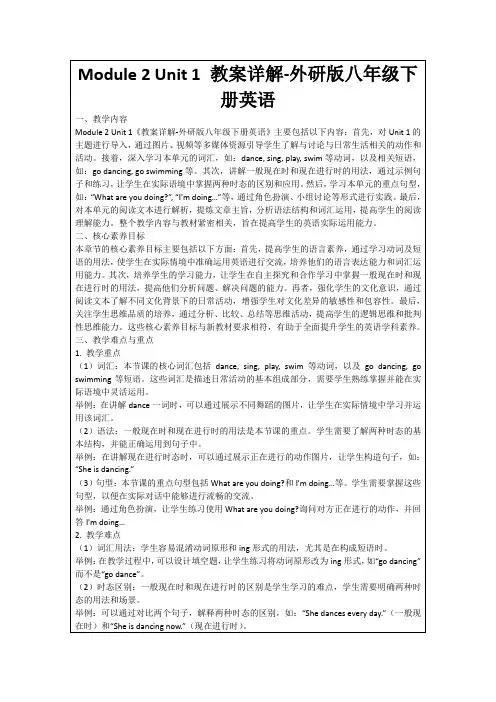
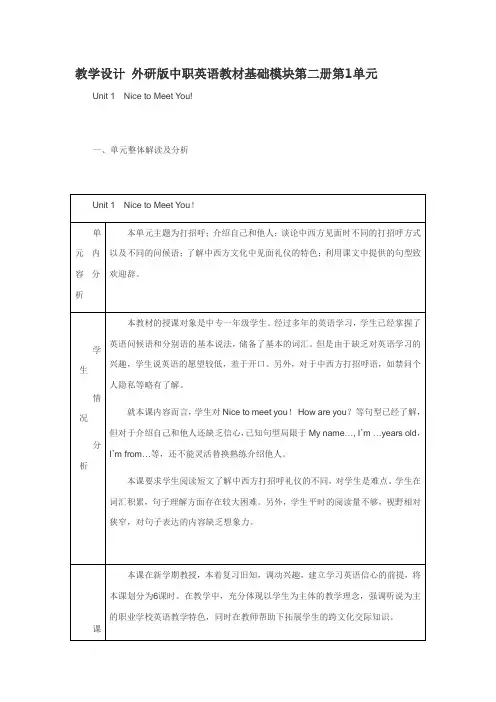
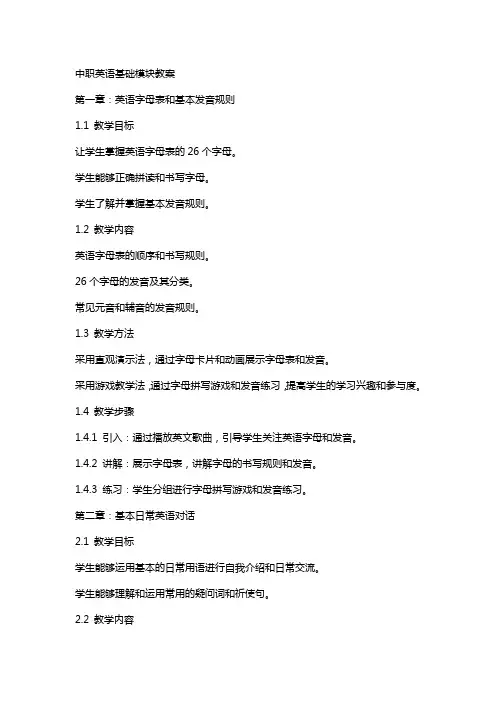
中职英语基础模块教案第一章:英语字母表和基本发音规则1.1 教学目标让学生掌握英语字母表的26个字母。
学生能够正确拼读和书写字母。
学生了解并掌握基本发音规则。
1.2 教学内容英语字母表的顺序和书写规则。
26个字母的发音及其分类。
常见元音和辅音的发音规则。
1.3 教学方法采用直观演示法,通过字母卡片和动画展示字母表和发音。
采用游戏教学法,通过字母拼写游戏和发音练习,提高学生的学习兴趣和参与度。
1.4 教学步骤1.4.1 引入:通过播放英文歌曲,引导学生关注英语字母和发音。
1.4.2 讲解:展示字母表,讲解字母的书写规则和发音。
1.4.3 练习:学生分组进行字母拼写游戏和发音练习。
第二章:基本日常英语对话2.1 教学目标学生能够运用基本的日常用语进行自我介绍和日常交流。
学生能够理解和运用常用的疑问词和祈使句。
2.2 教学内容自我介绍的常用句型和表达方式。
日常交流中的常用疑问词和祈使句。
常见的日常用语和表达方式。
2.3 教学方法采用情景教学法,通过模拟真实场景,让学生在实际情境中学习和应用日常用语。
采用交互式教学法,通过学生之间的对话和互动,提高学生的口语表达能力。
2.4 教学步骤2.4.1 引入:通过播放日常英语对话视频,引起学生的兴趣。
2.4.2 讲解:教师展示常用疑问词和祈使句,讲解其用法和意义。
2.4.3 练习:学生分组进行角色扮演,模拟真实场景进行日常对话练习。
第三章:英语数词和基本句型3.1 教学目标学生能够理解和运用1-100的英文数词。
学生能够运用基本的英语句型进行表达。
3.2 教学内容1-100的英文数词的写法和读法。
基本的英语句型及其用法。
3.3 教学方法采用直观教学法,通过数字卡片和实物展示,帮助学生理解和记忆数词。
采用任务驱动法,通过小组合作完成句子构建任务,提高学生的句型运用能力。
3.4 教学步骤3.4.1 引入:通过展示数字卡片,引导学生关注英文数词。
3.4.2 讲解:讲解1-100的英文数词的写法和读法,展示基本句型的结构。
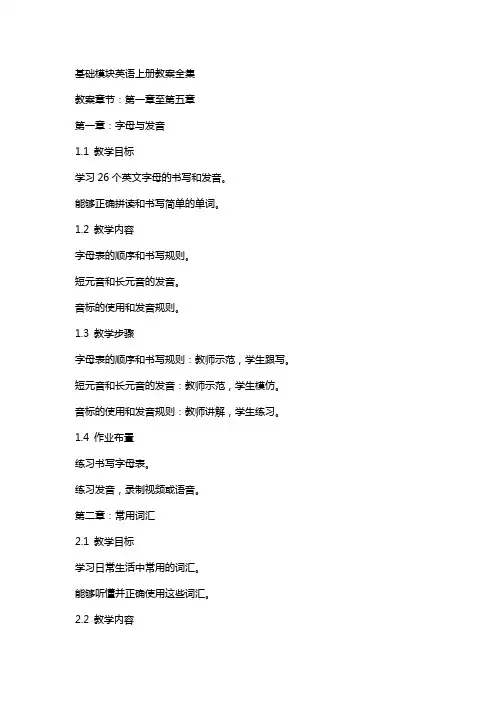
基础模块英语上册教案全集教案章节:第一章至第五章第一章:字母与发音1.1 教学目标学习26个英文字母的书写和发音。
能够正确拼读和书写简单的单词。
1.2 教学内容字母表的顺序和书写规则。
短元音和长元音的发音。
音标的使用和发音规则。
1.3 教学步骤字母表的顺序和书写规则:教师示范,学生跟写。
短元音和长元音的发音:教师示范,学生模仿。
音标的使用和发音规则:教师讲解,学生练习。
1.4 作业布置练习书写字母表。
练习发音,录制视频或语音。
第二章:常用词汇2.1 教学目标学习日常生活中常用的词汇。
能够听懂并正确使用这些词汇。
2.2 教学内容常用单词的书写和意思。
单词的例句和用法。
词汇的记忆技巧。
2.3 教学步骤教师展示单词,学生跟读。
教师给出例句,学生模仿。
学生分组练习,使用这些单词。
2.4 作业布置记忆单词,进行单词测试。
制作单词卡片,进行复习。
第三章:简单句型3.1 教学目标学习简单句型的构成和用法。
能够运用简单句型进行交流。
3.2 教学内容主谓宾句、主谓表句、主系表句的构成。
疑问句和否定句的使用。
句型的练习和应用。
3.3 教学步骤主谓宾句、主谓表句、主系表句的构成:教师讲解,学生练习。
疑问句和否定句的使用:教师示范,学生模仿。
句型的练习和应用:学生分组练习,进行角色扮演。
3.4 作业布置练习构成简单句型。
编写简单的对话,进行角色扮演。
第四章:日常对话4.1 教学目标学习日常对话的常用表达和礼貌用语。
能够运用所学知识进行日常交流。
4.2 教学内容问候和道别用语。
介绍和询问用语。
礼貌表达和回答问题。
4.3 教学步骤问候和道别用语:教师示范,学生模仿。
介绍和询问用语:教师展示,学生练习。
礼貌表达和回答问题:学生分组练习,进行角色扮演。
4.4 作业布置练习日常对话的常用表达。
进行角色扮演,录制视频或语音。
第五章:阅读与听力5.1 教学目标提高学生的阅读和听力能力。
能够理解简单的文章和对话。
5.2 教学内容简单文章的阅读理解。
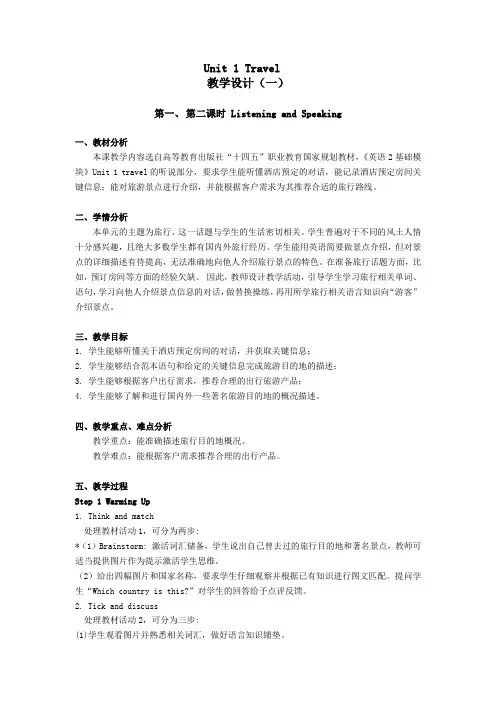
Unit 1 Travel教学设计(一)第一、第二课时 Listening and Speaking一、教材分析本课教学内容选自高等教育出版社“十四五”职业教育国家规划教材,《英语2基础模块》Unit 1 travel的听说部分,要求学生能听懂酒店预定的对话,能记录酒店预定房间关键信息;能对旅游景点进行介绍,并能根据客户需求为其推荐合适的旅行路线。
二、学情分析本单元的主题为旅行。
这一话题与学生的生活密切相关。
学生普遍对于不同的风土人情十分感兴趣,且绝大多数学生都有国内外旅行经历。
学生能用英语简要做景点介绍,但对景点的详细描述有待提高,无法准确地向他人介绍旅行景点的特色。
在准备旅行话题方面,比如,预订房间等方面的经验欠缺。
因此,教师设计教学活动,引导学生学习旅行相关单词、语句,学习向他人介绍景点信息的对话,做替换操练,再用所学旅行相关语言知识向“游客”介绍景点。
三、教学目标1. 学生能够听懂关于酒店预定房间的对话,并获取关键信息;2. 学生能够结合范本语句和给定的关键信息完成旅游目的地的描述;3. 学生能够根据客户出行需求,推荐合理的出行旅游产品;4. 学生能够了解和进行国内外一些著名旅游目的地的概况描述。
四、教学重点、难点分析教学重点:能准确描述旅行目的地概况。
教学难点:能根据客户需求推荐合理的出行产品。
五、教学过程Step 1 Warming Up1. Think and match处理教材活动1,可分为两步:*(1)Brainstorm: 激活词汇储备,学生说出自己曾去过的旅行目的地和著名景点,教师可适当提供图片作为提示激活学生思维。
(2)给出四幅图片和国家名称,要求学生仔细观察并根据已有知识进行图文匹配。
提问学生“Which country is this?”对学生的回答给予点评反馈。
2. Tick and discuss处理教材活动2,可分为三步:(1)学生观看图片并熟悉相关词汇,做好语言知识铺垫。
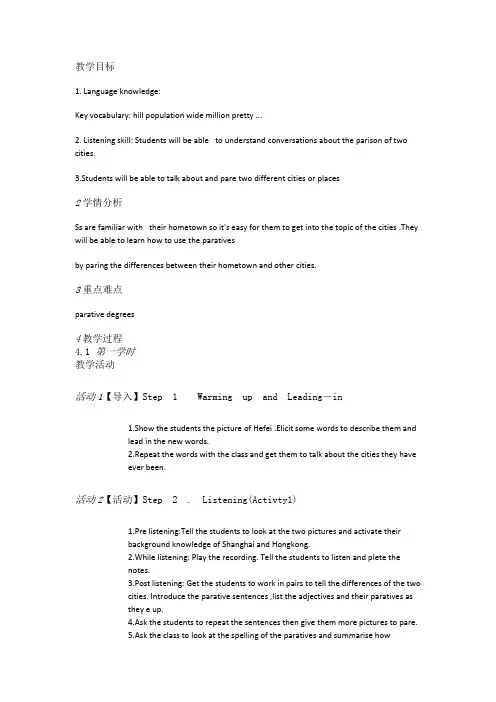
教学目标1. Language knowledge:Key vocabulary: hill population wide million pretty ...2. Listening skill: Students will be able to understand conversations about the parison of two cities.3.Students will be able to talk about and pare two different cities or places2学情分析Ss are familiar with their hometown so it's easy for them to get into the topic of the cities .They will be able to learn how to use the parativesby paring the differences between their hometown and other cities.3重点难点parative degrees4教学过程4.1 第一学时教学活动活动1【导入】Step 1 Warming up and Leading-in1.Show the students the picture of Hefei .Elicit some words to describe them andlead in the new words.2.Repeat the words with the class and get them to talk about the cities they haveever been.活动2【活动】Step 2 . Listening(Activty1)1.Pre listening:Tell the students to look at the two pictures and activate theirbackground knowledge of Shanghai and Hongkong.2.While listening: Play the recording. Tell the students to listen and plete thenotes.3.Post listening: Get the students to work in pairs to tell the differences of the twocities. Introduce the parative sentences ,list the adjectives and their paratives asthey e up.4.Ask the students to repeat the sentences then give them more pictures to pare.5.Ask the class to look at the spelling of the paratives and summarise howparative adjectives are formed.6.Put the students in pairs to pare two different things.活动3【讲授】Step 3. Listen and read (Activities2 and 3)1. Pre listening show a picture of Shenzhen , let the students tell what is pictureabout.2. First listening : Get the students to listen for the answers about Shengzhen andthen check the answer,elicit new words and expressions at the same time.3. Second listening : listen and plete the passage about Shenzhen.4. Listen and read: Play the recording and ask the students to read theconversation as they listen.5. Get the students to plete the sentences with the correct form of the words inthe box. Elicit answers from the whole class in full sentences. Then find out all thesentences with paratives.活动4【活动】Step 4:Post listening and reading(Activities 5, 61.Ask the students to work in pairs paring the differences between Beijing andShenzhen2. Get the students read the table and fill in it with information about Shenzhenand Hefei ,with notes to describe size, population, ways of life etc. in groups活动5【作业】HomeworkGet Ss to find out two big cities to pare by using the adjectives.Write a shortparagraph with the information .。
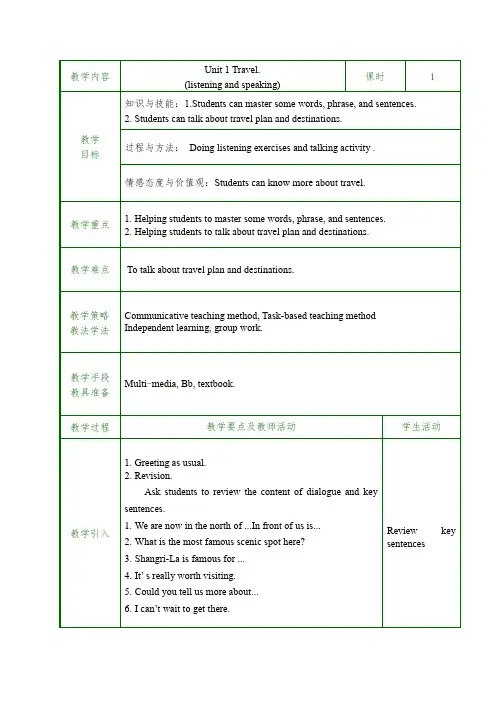
月日第 1 单元第1、2 课时总第1、2 课时(教学环节一般包括复习旧课、导入新课、讲授新课、学生操作、教师点评、归纳总结、布置作业等)月日第 1 单元第3、4 课时总第3、4 课时(教学环节一般包括复习旧课、导入新课、讲授新课、学生操作、教师点评、归纳总结、布置作业等月日第 1 单元第5、6 课时总第5、6 课时(教学环节一般包括复习旧课、导入新课、讲授新课、学生操作、教师点评、归纳总结、布置作业等)月日第 2 单元第1、2 课时总第7、8 课时(教学环节一般包括复习旧课、导入新课、讲授新课、学生操作、教师点评、归纳总结、布置作业等)月日第 2 单元第3、4 课时总第9、10 课时(教学环节一般包括复习旧课、导入新课、讲授新课、学生操作、教师点评、归纳总结、布置作业等月日第 2 单元第5、6 课时总第11、12 课时(教学环节一般包括复习旧课、导入新课、讲授新课、学生操作、教师点评、归纳总结、布置作业等)月日第 3 单元第1、2 课时总第13、14 课时(教学环节一般包括复习旧课、导入新课、讲授新课、学生操作、教师点评、归纳总结、布置作业等)月日第 3 单元第3、4 课时总第15、16 课时(教学环节一般包括复习旧课、导入新课、讲授新课、学生操作、教师点评、归纳总结、布置作业等月日第 3 单元第5、6 课时总第17、18 课时(教学环节一般包括复习旧课、导入新课、讲授新课、学生操作、教师点评、归纳总结、布置作业等)月日第 4 单元第1、2 课时总第19、20 课时(教学环节一般包括复习旧课、导入新课、讲授新课、学生操作、教师点评、归纳总结、布置作业等)教案纸月日第 4 单元第3、4 课时总第21、22 课时(教学环节一般包括复习旧课、导入新课、讲授新课、学生操作、教师点评、归纳总结、布置作业等教案纸月日第 4 单元第5、6 课时总第23、24 课时(教学环节一般包括复习旧课、导入新课、讲授新课、学生操作、教师点评、归纳总结、布置作业等)教案纸月日第 5 单元第1、2 课时总第25、26 课时(教学环节一般包括复习旧课、导入新课、讲授新课、学生操作、教师点评、归纳总结、布置作业等)教案纸月日第 5 单元第3、4 课时总第27、28 课时(教学环节一般包括复习旧课、导入新课、讲授新课、学生操作、教师点评、归纳总结、布置作业等教案纸月日第 5 单元第5、6 课时总第29、30 课时(教学环节一般包括复习旧课、导入新课、讲授新课、学生操作、教师点评、归纳总结、布置作业等)月日第 6 单元第1、2 课时总第31、32 课时(教学环节一般包括复习旧课、导入新课、讲授新课、学生操作、教师点评、归纳总结、布置作业等)月日第 6 单元第3、4 课时总第33、34 课时(教学环节一般包括复习旧课、导入新课、讲授新课、学生操作、教师点评、归纳总结、布置作业等月日第 6 单元第5、6 课时总第35、36 课时(教学环节一般包括复习旧课、导入新课、讲授新课、学生操作、教师点评、归纳总结、布置作业等)月日第7 单元第1、2 课时总第37、38 课时(教学环节一般包括复习旧课、导入新课、讲授新课、学生操作、教师点评、归纳总结、布置作业等)月日第7 单元第3、4 课时总第39、40 课时(教学环节一般包括复习旧课、导入新课、讲授新课、学生操作、教师点评、归纳总结、布置作业等月日第7 单元第5、6 课时总第41、42 课时(教学环节一般包括复习旧课、导入新课、讲授新课、学生操作、教师点评、归纳总结、布置作业等)月日第8 单元第1、2 课时总第43、44 课时(教学环节一般包括复习旧课、导入新课、讲授新课、学生操作、教师点评、归纳总结、布置作业等)月日第8 单元第3、4 课时总第45、46 课时(教学环节一般包括复习旧课、导入新课、讲授新课、学生操作、教师点评、归纳总结、布置作业等月日第8 单元第5、6 课时总第47、48 课时(教学环节一般包括复习旧课、导入新课、讲授新课、学生操作、教师点评、归纳总结、布置作业等)月日第9 单元第1、2 课时总第49、50 课时(教学环节一般包括复习旧课、导入新课、讲授新课、学生操作、教师点评、归纳总结、布置作业等)。
Book 2 Unit 1 I laughed till I cried!课时:2课时一. 教学内容能够听懂并谈论家庭在假期中的活动,掌握提供以及询问过去的经历的词汇和句型。
二. 教学重点、难点⑴ 教学重点能够听懂并谈论家庭在假期中的活动,掌握询问以及提供过去的经历的词汇和句型。
⑵ 教学难点提供以及询问过去的经历的词汇和句型三.教学目标1. 知识目标⑴ 帮助学生掌握以下词汇:如ski, mountain, beach, sail, skate, vacation, wonderful, parent等⑵ 帮助学生掌握询问和提供过去的经历所使用的词组和句型,如:a. useful expressions about some activities:visit the zoo, go swimming / skating / skiing / boating / sailing / fishing, pick apples, climb mountains, play volleyball on the beach, etc.b. ask for and give information on past experiences:How was your vacation?It was wonderful / great / not bad.We had great fun.Where did your family go? / Where did you go?I went to …. / We went to ….What did you do there?2. 能力目标⑴ 学生能听懂关于询问和提供过去的经历的对话。
⑵ 学生能就过去的经历这一话题进行简单的交流,能够就这一话题询问和提供信息。
3. 情感目标在真实情景交流中,让学生学会与同伴分享自己的经历,健康快乐地成长。
四、教学步骤Step One Lead-in (25 mins)1. The teacher greets each student:Good morning.Nice to see you again.Welcome back to school.What did you do during your winter vacation?Did your family go somewhere?Did you enjoy yourselves?(设计意图:这是学生寒假回来的第一节英语课,和学生互相问候了之后,顺便聊到寒假里的活动是再自然不过的事了。
Unit 1We laughed into tears!Part1: 教材分析(Analysis of the teaching material)本课时系教材《英语 2 》(基础模块高教版)第一单元的第一部分,学生听一段关于和家人度假描述的对话。
训练学生在一定的语境下用合适的方式和语句组织关于描述假期活动的对话。
Part2: 教学目标(Teaching aims)Ss can understand expression of vacation description and make a dialogue discussing vacationLead-inAsk the students where did they go and what they did in the summer vacation and winter vacation. (Group discussion and then answer my questions)Step1:Lead students read the phrases and ask Ss to tick the activities they had taken part in.then check the answer.Step2:Teacher show the pictures for the Ss , explain the requests and then play the radio for theSs. Next, teacher asks some students to answer these questions.Listening & SpeakingPart1: 教材分析(Analysis of the teaching material)本课时系教材《英语 2 》(基础模块高教版)第一单元的听力及口语第一部分,学生听一段关于 Cindy 和家人度假描述的对话。
宁德职业技术学院教学过程与内容:Ⅰ. Greeting Ⅱ. PreviewHave a comment on Ss ’ compositions. Pick out some good examples and get the Ss to read them aloud. After reading, ask some questions.(设计意图:教师对于上一课时的学生作文进行讲评,能让学生明确并及时订正自己的差错。
对于优秀作文的肯定及在全班的示范朗读,更能激发学生的自豪感,从而更主动积极地完成作业。
在朗读前,明确任务,听后要回答问题。
这样既能让听的同学更集中注意力,也有意识地培养了大家尊重他人的品质。
) Ⅲ. Lead-inTell the Ss the basic structure of the Past Tense. Ask the Ss if they know the past forms of verbs. Bb: 一般过去时: 动词的过去式(设计意图:在学生作文朗读结束后,教师告诉学生,作文中大家用来描述过去的经历要使用一般过去时。
在之前的听说课和阅读写作课中,学生们实际上已经在运用这一时态。
因此,教师在这里开门见山地提出了本课时要解决的问题。
而问题的提出:什么是动词的过去式?即在下一步骤中马上得到解决。
) Ⅳ. Contents ’ presentation Language in Use1. Game: Get the Ss to put the words into the right envelope.played danced studied stopped went cried came did read returned replied listened watched chatted had enjoyed cooked stayed gave slipped counted asked sent arrived started was were(设计意图:这一游戏要求学生按照已给的例子,把其他的单词放进正确的信封中。
这里其实在复习动词的过去式的变化规则。
而采用游戏和竞赛的方式,可以化枯燥为有趣,让学生played studied stoppedwentdanced 一般直接+ed以不发音e结尾+d以辅音字母+y ,则去y 加ied 重读闭音节结尾,双写最后一个字母,然后+ed不规则变化在玩中学、做中学。
在学生把这些单词全部放入正确的位置后,可以让他们自己来归纳动词过去式的变化规则。
教师还可以在这里让学生根据这些过去式,说出它们的原形。
在这里选用的动词,大多数为本单元中出现的词汇,学生比较熟悉。
而对于不规则变化的动词,教师可以在后面的课时中慢慢补充,帮助学生查漏补缺。
) 2. Game: who + what + where + whenDivide the Ss into four groups. Students of each group write a part of a sentence. Help them to use the past forms of verbs. Then each group leader hand in what their group members write. There are four boxes on the teachers ’ desk. Each box collects one part. Then Ss can read what they write.(设计意图,找出课文中的关键活动,初步理解课文。
)3. Activity 12. Read the letters again and tick the correct sentences. Then check the answers with the Ss. See if they have any problems, help them with some important and difficult points.(设计意图:这一游戏虽然并不新鲜,但在学生中却十分受欢迎。
学生们总是十分喜欢谈论自己的同伴,有着这个年龄特有的爱搞恶作剧的特点。
同学们在每个盒子中随意各抽出一张纸条,然后组合起来,往往期待一个搞笑的场景。
而学生在说的过程中,教师可以帮助学生理清各部分在句子中的位置。
而这一游戏也为下一活动做了一个很好的铺垫。
不过,要注意学生在写what 和when 这两部分时,要提醒他们用动词的过去式以及表示过去的时间状语。
) 3. Practice.Get the Ss to reorder the words to form a sentence. a. played volleyball my dad and I b. enjoyed the holiday we c. went sailing I with my brother d. had a great time we e. was ill last weekend Mum f. yesterday were at home my parentsLi Jiedancedin theclassroomlast nightAsk the Ss to do the exercises orally as quick as possible and check the answers with the whole class.(设计意图:延续谁在何时何地做什么事情这一游戏,教师没有直接把例句展示给学生,而是把例句改编成简单的练习,让学生自己说出正确的句子。
学生在说出正确的句子后,会有一种成就感。
这样,他们在学习例句时,就不会感觉到枯燥和乏味。
)4. Grammar Focus: Get the Ss to read these sample sentences together. Help them to learn the examples. Ask them to pay special attention to the verb forms and the adverbial phrases of time. (设计意图:教师只需稍稍提醒他们注意动词的形式和相应的时间状语即可。
帮助学生仔细学习一般过去时的肯定式和否定式。
)5. Activity 16: Get the Ss to complete the exercises. Then check the answers with them.(设计意图:在完成此活动之前,学生对排列句子的顺序在游戏中已经得到了充分的练习,而且又已经认真学习了例句。
因此,在完成这一练习时,他们就比较得心应手了。
)6. Activity 17.a. Books closed. Ask the Ss some questions to see if they can describe pictures in Activity 16 without looking at the books.T: What did Tom do this morning?Did Tom read a book this morning?Did Harry read a book yesterday afternoon?What did Lisa do yesterday afternoon?Did she dance yesterday afternoon?What did Mom and Dad do last Sunday?Did the men play volleyball two days ago?What did Zhang Ming do last night?Did he search for information on the Internet?T: (Ask some questions about the Ss themselves.)What did you do yesterday evening?Were you at home yesterday evening?What did Li Jie do yesterday evening?Was she at home yesterday evening?According to the general questions, help the Ss to answer them with Yes, … did. / No, … didn’t. Yes, … was / were. / No, … wasn’t / weren’t.b. Get the Ss to complete Activity 17. Then check the answers with them.(设计意图:在完成活动17前,可先检测学生对活动16的掌握程度。
而在检测时,教师提问的时候有意识地使用了很多一般疑问句,帮助学生用Yes/No来回答。
在学生回答时,提醒他们注意提问和回答的一致性。
)7. Activity 17: Chain drills. Ask the Ss to ask their partners more questions. Start with “did, was or were”.(设计意图:帮助学生模仿活动16中的例子,让他们在这里进行快速地问答,可以有效地检查他们对一般疑问句的掌握程度。
)Listening1. Before listening, ask the Ss to look at the pictures and talk about what cities they may be.2. Activity3. Listen and tick. Then heck the answers with them.3. Activity 5. Listen again and match the people with the activities. Check the answers with them.4. Activity 4. Listen again and answer the questions. Check the answers with them.(设计意图: 在听之前,让学生先讨论教材中的图片能让他们先熟悉要听的内容。
接着,要让他们明白在听的过程中要完成的任务。
把教材中的活动4和活动5调整了一下顺序是因为学生对于回答问题总是比较害怕,也觉得比较难。